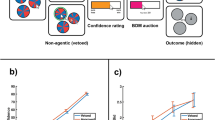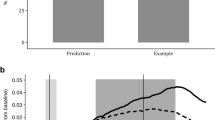Abstract
Curiosity—our desire to know—is a fundamental drive in human behaviour, but its mechanisms are poorly understood. A classical question concerns the curiosity motives. What drives individuals to become curious about some but not other sources of information?1 Here we show that curiosity about probabilistic events depends on multiple aspects of the distribution of these events. Participants (n = 257) performed a task in which they could demand advance information about only one of two randomly selected monetary prizes that contributed to their income. Individuals differed markedly in the extent to which they requested information as a function of the ex ante uncertainty or ex ante value of an individual prize. This heterogeneity was not captured by theoretical models describing curiosity as a desire to learn about the total rewards of a situation2,3. Instead, it could be explained by an extended model that allowed for attribute-specific anticipatory utility—the savouring of individual components of the eventual reward—and postulates that this utility increased nonlinearly with the certainty of receiving the reward. Parameter values fitting individual choices were consistent for information about gains or losses, suggesting that attribute-specific anticipatory utility captures fundamental heterogeneity in the determinants of curiosity.
This is a preview of subscription content, access via your institution
Access options
Access Nature and 54 other Nature Portfolio journals
Get Nature+, our best-value online-access subscription
$29.99 / 30 days
cancel any time
Subscribe to this journal
Receive 12 digital issues and online access to articles
$119.00 per year
only $9.92 per issue
Buy this article
- Purchase on Springer Link
- Instant access to full article PDF
Prices may be subject to local taxes which are calculated during checkout




Similar content being viewed by others
Data availability
Requests for the data can be sent via email to the corresponding author.
Code availability
Requests for the code used for all analyses can be sent via email to the corresponding author.
References
Berlyne, D. E. A theory of human curiosity. Br. J. Psychol. 45, 180–191 (1954).
Kreps, D. M. & Porteus, E. L. Temporal resolution of uncertainty and dynamic choice theory. Econometrica 46, 185–200 (1978).
Iigaya, K., Story, G. W., Kurth-Nelson, Z., Dolan, R. J. & Dayan, P. The modulation of savouring by prediction error and its effects on choice. eLife 5, e13747 (2016).
Loewenstein, G. The psychology of curiosity: a review and reinterpretation. Psychol. Bull. 116, 75–98 (1994).
Gottlieb, J. & Oudeyer, P. Y. Toward a neuroscience of active sampling and curiosity. Nat. Rev. Neurosci. 19, 758–770 (2018).
Gottlieb, J., Oudeyer, P. Y., Lopes, M. & Baranes, A. Information seeking, curiosity and attention: computational and empirical mechanisms. Trends Cogn. Sci. 17, 585–593 (2013).
Kidd, C. & Hayden, B. Y. The psychology and neuroscience of curiosity. Neuron 88, 449–460 (2015).
Loewenstein, G. & Molnar, A. The renaissance of belief-based utility in economics. Nat. Hum. Behav. 2, 166–167 (2018).
Vasconcelos, M., Monteiro, T. & Kacelnik, A. Irrational choice and the value of information. Sci. Rep. 5, 13874 (2015).
Eliaz, K. & Schotter, A. Experimental testing of intrinsic preferences for noninstrumental information. Am. Econ. Rev. 97, 166–169 (2007).
Zentall, T. R. & Stagner, J. P. Do pigeons prefer information in the absence of differential reinforcement? Learn. Behav. 40, 465–475 (2012).
Bromberg-Martin, E. S. & Hikosaka, O. Midbrain dopamine neurons signal preference for advance information about upcoming rewards. Neuron 63, 119–126 (2009).
Blanchard, T. C., Hayden, B. Y. & Bromberg-Martin, E. S. Orbitofrontal cortex uses distinct codes for different choice attributes in decisions motivated by curiosity. Neuron 85, 602–614 (2015).
Baranes, A. F., Oudeyer, P. Y. & Gottlieb, J. Eye movements encode epistemic curiosity in human observers. Vis. Res. 117, 81–90 (2015).
Daddaoua, N., Lopes, M. & Gottlieb, J. Intrinsically motivated oculomotor exploration guided by uncertainty reduction and conditioned reinforcement in non-human primates. Sci. Rep. 6, 20202 (2016).
Gruber, M. J., Gelman, B. D. & Ranganath, C. States of curiosity modulate hippocampus-dependent learning via the dopaminergic circuit. Neuron 84, 486–496 (2014).
Cohen, J. D., McClure, S. M. & Yu, A. J. Should I stay or should I go? How the human brain manages the trade-off between exploitation and exploration. Phil. Trans. R. Soc. Lond. B 362, 933–942 (2007).
Loewenstein, G. Anticipation and the valuation of delayed consumption. Econ. J. 97, 666–684 (1987).
Caplin, A. & Leahy, J. Psychological expected utility theory and anticipatory feelings. Q. J. Econ. 116, 55–79 (2001).
Kahnt, T., Park, S. Q., Haynes, J. D. & Tobler, P. N. Disentangling neural representations of value and salience in the human brain. Proc. Natl Acad. Sci. USA 111, 5000–5005 (2014).
Carver, C. S. & White, T. L. Behavioral Avoidance/Inhibition (BIS/BAS) Scales (Measurement Instrument Database for the Social Sciences, 2013).
Gard, D. E., Gard, M. G., Kring, A. M. & John, O. P. Anticipatory and consummatory components of the experience of pleasure: a scale development study. J. Res. Pers. 50, 1086–1102 (2006).
Foa, E. B. et al. The obsessive–compulsive inventory: development and validation of a short version. Psychol. Assess. 14, 485–496 (2002).
Spielberger, C. D. Manual for the State-Trait Anxiety Inventory (Mind Garden, 1983).
Radloff, L. S. The CES-D scale: a self-report depression scale for research in the general population. Appl. Psych. Meas. 1, 385–401 (1977).
Litman, J. A. Interest and deprivation factors of epistemic curiosity. Pers. Individ. Dif. 44, 1585–1595 (2008).
Litman, J. A. & Spielberger, C. D. Measuring epistemic curiosity and its diversive and specific components. J. Pers. Assess. 80, 75–86 (2003).
Blais, A.-R. & Weber, E. U. A domain-specific risk-taking (DOSPERT) scale for adult populations. Judgm. Decis. Mak. 1, 33–47 (2006).
Van Lieshout, L. L. F., Vandenbroucke, A. R. E., Müller, N. C. J., Cools, R. & de Lange, F. P. Induction and relief of curiosity elicit parietal and frontal activity. J. Neurosci. 38, 2579–2588 (2018).
Friston, K., FitzGerald, T., Rigoli, F., Schwartenbeck, P. & Pezzulo, G. Active inference: a process theory. Neural Comput. 29, 1–49 (2017).
Anderson, B. The attention habit: how reward learning shapes attentional selection. Ann. NY Acad. Sci. 1369, 24–39 (2016).
Sharot, T. The optimism bias. Curr. Biol. 21, 941–945 (2011).
Barbaro, L., Peelen, M. V. & Hickey, C. Valence, not utility, underlies reward-driven prioritization in human vision. J. Neurosci. 37, 10438–10450 (2017).
Morvan, C. & Maloney, L. Human visual search does not maximize the post-saccadic probability of identifying targets. PLoS Comput. Biol. 8, e1002342 (2012).
Hunt, L. T., Rutledge, R. B., Malalasekera, W. M., Kennerley, S. W. & Dolan, R. J. Approach-induced biases in human information sampling. PLoS Biol. 14, e2000638 (2016).
Sugrue, L. P., Corrado, G. S. & Newsome, W. T. Choosing the greater of two goods: neural currencies for valuation and decision making. Nat. Rev. Neurosci. 6, 363–375 (2005).
Kable, J. W. & Glimcher, P. W. The neurobiology of decision: consensus and controversy. Neuron 63, 733–745 (2009).
Schultz, W. et al. Explicit neural signals reflecting reward uncertainty. Phil. Trans. R. Soc. Lond. B 363, 3801–3811 (2008).
O’Neill, M. & Schultz, W. Coding of reward risk by orbitofrontal neurons is mostly distinct from coding of reward value. Neuron 68, 789–800 (2010).
Monosov, I. E. & Hikosaka, O. Selective and graded coding of reward uncertainty by neurons in the primate anterodorsal septal region. Nat. Neurosci. 16, 756–762 (2013).
Monosov, I. E., Leopold, D. A. & Hikosaka, O. Neurons in the primate medial basal forebrain signal combined information about reward uncertainty, value, and punishment anticipation. J. Neurosci. 35, 7443–7459 (2015).
Levy, I., Lazzaro, S. C., Rutledge, R. B. & Glimcher, P. W. Choice from non-choice: predicting consumer preferences from blood oxygenation level-dependent signals obtained during passive viewing. J. Neurosci. 31, 118–125 (2011).
Zajkowski, W. K., Kossut, M. & Wilson, R. C. A causal role for right frontopolar cortex in directed, but not random, exploration. eLife 6, e27430 (2017).
Wilson, R. C. & Niv, Y. Inferring relevance in a changing world. Front. Hum. Neurosci. 5, 189 (2011).
Bennett, D., Bode, S., Brydevall, M., Warren, H. & Murawski, C. Intrinsic valuation of information in decision making under uncertainty. PLoS Comp. Biol. 12, e1005020 (2016).
Fritz, C. O., Morris, P. E. & Richler, J. J. Effect size estimates: current use, calculations, and interpretation. J. Exp. Psychol. Gen. 141, 2–18 (2011).
DiCiccio, T. J. & Efron, B. Boostrap confidence intervals. Stat. Sci 11, 189–228 (1996).
Shadlen, M. N., Hanks, T. D., Churchland, A. K., Kiani, R. & Yang, T. The speed and accuracy of a simple perceptual decision: a mathematical primer. in Bayesian Brain: Probabilistic Approaches to Neural Coding (eds Doya, K. et al.) Ch. 10 (MIT Press, 2006).
Acknowledgements
The work was supported by a Human Frontiers Cross-Disciplinary Fellowship (to A.B.), Presidential Scholars in Science and Society Seed Grant at Columbia University (to M.W. and J.G.), Research Initiatives in Science and Engineering Seed Grant at Columbia University (to M.W. and J.G.), National Science Foundation grant SES-1426168 (to M.W.) and the Cognitive and Behavioral Economics Initiative at Columbia University (to S.R.). We thank M. Jameson and J. Capaldi for expert administrative assistance. The funders had no role in study design, data collection and analysis, decision to publish or preparation of the manuscript.
Author information
Authors and Affiliations
Contributions
J.G. designed the experiment. K.K., S.R. and A.B. implemented the task and collected the data. K.K. analysed the data. M.W. wrote the computational model. K.K., S.R., M.W. and J.G. interpreted the results and wrote the paper.
Corresponding author
Ethics declarations
Competing interests
The authors declare no competing interests.
Additional information
Publisher’s note: Springer Nature remains neutral with regard to jurisdictional claims in published maps and institutional affiliations.
Supplementary information
Supplementary Information
Supplementary Notes 1–4, Supplementary references, Supplementary Figs. 1–5, and Supplementary Tables 1–4.
Rights and permissions
About this article
Cite this article
Kobayashi, K., Ravaioli, S., Baranès, A. et al. Diverse motives for human curiosity. Nat Hum Behav 3, 587–595 (2019). https://doi.org/10.1038/s41562-019-0589-3
Received:
Accepted:
Published:
Issue Date:
DOI: https://doi.org/10.1038/s41562-019-0589-3
This article is cited by
-
A neural mechanism for conserved value computations integrating information and rewards
Nature Neuroscience (2024)
-
Inefficient prioritization of task-relevant attributes during instrumental information demand
Nature Communications (2023)
-
Hedonism as a motive for information search: biased information-seeking leads to biased beliefs
Scientific Reports (2023)
-
People are curious about immoral and morally ambiguous others
Scientific Reports (2023)
-
Multifaceted information-seeking motives in children
Nature Communications (2023)



